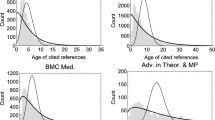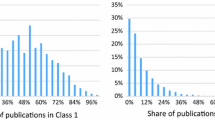Abstract
One of the most important requirements of building applicable models and meaningful indicators for the use of scientometrics at the micro and meso level is the correct identification and disambiguation of authors and institutes. Platforms like ResearcherID or ORCID with author registration providing high reliability but lower coverage now provide appropriate data sets for the development and testing of stochastic models describing the publication activity and citation impact of individual authors. This paper proposes a triangular model incorporating papers, citations and authors analogously to the dichotomous model used at higher levels of aggregation like countries or fields. This model is applied to a set of authors in any field of science identified by their ResearcherID. However, the main advantage of classical citation indicators to study citation impact under conditional productivity turned out to be the main problem in this triangle: the possible heterogeneity of the collaborating authors results in low robustness. A mere technical solution to this problem would be fractional counting at three levels but the conceptual issue, the different roles of co-authors causing this heterogeneity will never be solved by any algorithm.




Similar content being viewed by others
References
Braun, T., Glänzel, W., & Schubert, A. (2001). Publication and cooperation patterns of the authors of neuroscience journals. Scientometrics, 51(3), 499–510.
Caron, E., van Eck, N. J. (2014). Large scale author name disambiguation using rule-based scoring and clustering. In E. Noyons (Ed.), Context counts: Pathways to master big and little data. Proceedings of the STI conference 2014, Leiden University, pp. 79–86.
Glänzel, W. (2007). Characteristic scores and scales. A bibliometric analysis of subject characteristics based on long-term citation observation. Journal of Informetrics, 1(1), 92–102.
Glänzel, W., Heeffer, S., & Thijs, B. (2015). A model for publication and citation statistics of individual authors. In A. A. Salah, Y. Tonta, A. A. Salah, C. Sugimoto, & U. Al (Eds.), Proceedings of ISSI 2015—The 15th international conference on scientometrics and informetrics (pp. 942–952). Turkey: Istanbul.
Glänzel, W., & Schoepflin, U. (1994). A stochastic model for the ageing analyses of scientific literature. Scientometrics, 30(1), 49–64.
Glänzel, W., & Schoepflin, U. (1995). A bibliometric study on ageing and reception processes of scientific literature. Journal of Information Science, 21(1), 37–53.
Glänzel, W., & Schubert, A. (1988). Characteristic scores and scales in assessing citation impact. Journal of Information Science, 14(2), 123–127.
Glänzel, W., & Schubert, A. (2003). A new classification scheme of science fields and subfields designed for scientometric evaluation purposes. Scientometrics, 56(3), 357–367.
Glänzel, W., Schubert, A., Thijs, B., & Debackere, K. (2009). Subfield-specific normalized relative indicators and a new generation of relational charts: Methodological foundations illustrated on the assessment of institutional research performance. Scientometrics, 78(1), 165–188.
Glänzel, W., Thijs, B., & Debackere, K. (2014). The application of citation-based performance classes to the disciplinary and multidisciplinary assessment in national comparison and institutional research assessment. Scientometrics, 101(2), 939–952.
Heeffer, S., Thijs, B., & Glänzel, W. (2013). Are registered authors more productive? ISSI Newsletter, 9(2), 29–32.
Hirsch, J. E. (2005). An index to quantify an individual’s scientific research output. Proceedings of the National Academy of Sciences of the United States of America, 102(46), 16569–16572.
Hirsch, J. E. (2010). An index to quantify an individual’s scientific research output that takes into account the effect of multiple co-authorship. Scientometrics, 85(3), 741–754.
Moed, H. F., van Leeuwen, T. N., & Reedijk, J. (1998). A new classification system to describe the ageing of scientific journals and their impact factors. Journal of Documentation, 54(4), 387–419.
Price, D. D., & Gürsey, S. (1976). Studies in scientometrics. Part 1. Transience and continuance in scientific authorship. International Forum on Information and Documentation., 1, 17–24.
Reuters, T. (2012). Web of Science® Help. Accessible at: http://images.webofknowledge.com/WOKRS58B4/help/WOS/hp_das1.html. Last modified on 09/18/2012, accessed on 28/12/2014.
Ruiz-Castillo, J., & Costas, R. (2014). The skewness of scientific productivity. Journal of Informetrics, 8(4), 917–934.
Schubert, A. (2007). Successive h-indices. Scientometrics, 70(1), 201–205.
Schubert, A., & Glänzel, W. (1984). A dynamic look at a class of skew distributions. A model with scientometric applications. Scientometrics, 6(3), 149–167.
Strotman, A., & Zhao, D. (2012). Author name disambiguation: What difference does it make in author-based citation analysis? JASIST, 63(9), 1820–1833.
Tang, L., & Walsh, J. P. (2010). Bibliometric fingerprints: Name disambiguation based on approximate structure equivalence of cognitive maps. Scientometrics, 84(3), 763–784.
Thijs, B., Debackere, K., & Glänzel, W. (2014). Improved author profiling through the use of citation classes. In E. Noyons (Ed.), Context counts: Pathways to master big and little data. Proceedings of the STI Conference 2014, Leiden University, pp. 616–622.
Acknowledgments
The present study is an extended version of an article presented at the 15th International Conference on Scientometrics and Informetrics, Istanbul (Turkey), 29 June–4 July 2015 (Glänzel et al. 2015).
Author information
Authors and Affiliations
Corresponding author
Rights and permissions
About this article
Cite this article
Glänzel, W., Heeffer, S. & Thijs, B. A triangular model for publication and citation statistics of individual authors. Scientometrics 107, 857–872 (2016). https://doi.org/10.1007/s11192-016-1870-0
Received:
Published:
Issue Date:
DOI: https://doi.org/10.1007/s11192-016-1870-0




